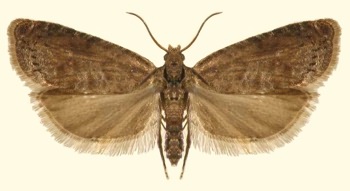Pests
Laspeyresia funebrana Treitschke - Plum Fruitworm, Plum Fruit Moth.
Systematic position.
Class Insecta, order Lepidoptera, family Tortricidae, subfamily Olethreutinae, tribe Laspeyresiini, genus Grapholita. The subspecies G. f. cerasivora (Matsumura) is recognized in the Far East and Transbaikalia; Japanese researchers consider it as independent species.Synonyms.
G. cerasana Kozh., G. cerasivora (Matsumura), Grapholita funebrana (Tr.).Biological group.
Oligophagous pest of stone-fruit rosaceous crops.Morphology and biology.
Moth wingspan 12-15 mm. Forewings grayish-brown with violet shine. Tapetum rather diffuse, with 3-4 black strokes or dots inside. Hindwings brownish-gray, lighter at base. Egg greenish-white, translucent, flattened, to 0.7 mm. Caterpillar 12-15 mm in length, dirty-white; becoming carmine-red, light pink laterally and ventrally, when feeding is finished. Pupa yellowish-brown, 6-8 mm in length, with smoothly rounded abdominal apex bearing 8 hooked setae. Fertility is 40-85 eggs on the average. Females of 1st generation lay eggs on fruits, less often on the lower surface of leaves. Moths of 2nd generation lay eggs on ripening fruits. Eggs develop in 7-11 days. Hatched caterpillar makes a hole in pulp toward petiole. Reaching petiole in 3-5 days after intrusion into fruit, it disrupts vascular system and breaks nutrient supply. The caterpillars frequently damage stone in young fruitlets; later they gnaw out cavities in pulp around the stone, filling the cavities with their excrement. The caterpillars. period of development lasts 17-30 days; pupae develop 15-33 days. Diapausing caterpillars of last instar winter after finishing feeding, situating inside dense silk cocoons covered with particles of bark, vegetation residues, or soil.Distribution.
Inhabits Europe, Asia Minor, Northwest Africa, China, Japan, Korea, Ukraine, Moldova, Transcaucasia, Kazakhstan, Central Asia. In Russia it is distributed in the entire European part (except for the north forest zone), in the Caucasus, southern Siberia, the Far East (the Amur Region, Khabarovsk and Primorskii Territories, Sakhalin, Southern Kurils).Ecology.
In the north part of the area, in middle belt of the European part of the former USSR, and in the Amur Region 1-1.5 generations develop; 2-3 in the south of the Far East, in the Northern Caucasus, Moldova, Ukraine, Central Asia, and Kazakhstan; 3 generations in Transcaucasia and Turkmenistan. Pupation of wintered caterpillars begins 10-15 days after transition of daily average temperature through 10°C, i.e., in middle or at the end of April depending on air temperature. Degree days 105-120° (at a threshold above 10°C) is necessary for start of the 1st generation of moth flight in Ukraine. The flight period lasts 35-50 days. Moths live 4-15 days; they usually do not require feeding. The start of 2nd generation moth flight begins in Ukraine in the 2nd half of June, less often in the beginning of July, and mass flight occurs over 7-10 days. Eggs are laid by females of the wintered generation in May in Dagestan and in 1st third of June in Kazakhstan. Degree days for development of caterpillars of spring generation reach 190-200° in Ukraine. Diapausing caterpillars appear mainly from the end of July and in August.Economic significance.
Damages plum, apricot, cherry plum, peach, sloe; seldom cherry, sweet cherry. Damages also Padus maximowiczii in the south of Siberia and the Far East, being found on pome fruit rosaceous, especially on Pirus ussuriensis, less often on dog-rose and hawthorn. Disrupting vascular system of fruits, the caterpillars break their supply. The damaged fruits stop their growth, prematurely paint themselves, and soon fall down. The pest of the 2nd generation is especially nocuous, damaging 70-80% of fruits. Control measures are agronomical first of all, i.e., cleaning of trunks and skeletal branches from old bark, removal of vegetation residues, autumn plowing and digging of ground around trunks for destruction of wintering caterpillars, use of trapping bands at trunk base; gathering of fruit droppings with subsequent removal from garden; duly cleaning of early plum varieties during undertime. Application of biological preparations is also used. Insecticide treatments during egg hatching before intrusion of caterpillars into fruits are recommended in centers populated by the pest. Mating disruption, monitoring and forecasting by use of pheromones are helpful.Related references.
D.yakonov A.M. & Kozhanchikov I.V. 1949. Lepidoptera. In: Pavlovskii E.N. & Shtakelberg A.A., eds. Pest Animals of Middle Asia (handbook). Moscow & Leningrad: AN SSSR: 179-198 (in Russian)Danilevskii A.S., Kuznetsov V.I. 1968. Tortricidae, tribe Laspeyresiini. Moscow & Leningrad: AN SSSR, 636 p. (Bykhovskii B.E., ed. Fauna of the USSR, new ser., N 98. Lepidoptera. V. 5(1). (in Russian).
Ermolaev V.P. 1988. Tortricidae. In: Kirpichnikova V.A., Ler P.A., eds. Butterflies - pests of agriculture in the Far East. Keys. Vladivostok: Biology and Soil Institute, DO AN SSSR: 65-99 (in Russian)
Kostyuk Yu.A. 1974. Family Tortricidae. In: Vasil.ev, V.P., ed. Pests of agricultural crops and forest plantations. V.2. Arthropods.Kiev: Urozhai, p. 261-320 (in Russian).
Kuznetsov V.I. 1994. Family Tortricidae. In: Kuznetsov, V.I., ed. Insects and mites - pests of agricultural plants. V. 3(1).Lepidoptera. St.Petersburg: Nauka, p. 51-234 (in Russian).
Prokof.ev M.A. 1987. Siberian orchards protection against pests. Moscow: Rossel.khozizdat, 239 p. (in Russian).s.
Vasil.ev V.P., Livshits I.Z. 1984. Pests of fruit crops. Moscow: Kolos, 399 p. (in Russian).


